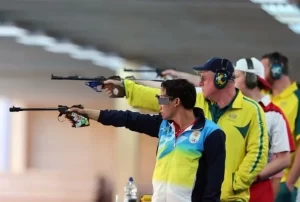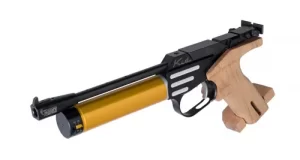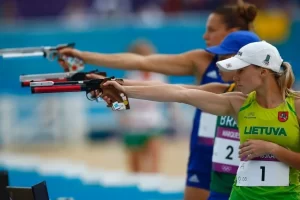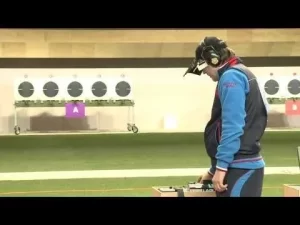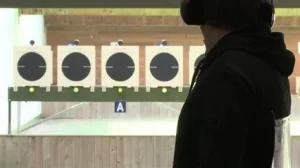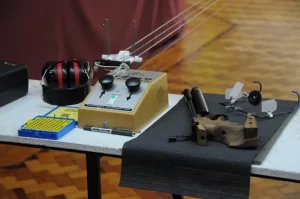Hume Pistol Club
The Hume Pistol Club is a multi discipline complex located 10 minutes from the Albury CBD.
Our complex began as a small four range facility and due to the continuing volunteer efforts of club members over the last 50 years it now consists of seven outdoor ranges and an indoor Air Pistol Range.
All these ranges are able to be used seven days a week by club members and various organisations such as NSW police, Security Organisation and Australian Targeting Systems.
Through the years we have hosted state and national level events and club members have represented Australia at International events. We welcome newcomers to our sport and offer training, coaching and safety courses for all.
Shooting Disciplines
International Practical Shooting Confederation (IPSC)
The sport of Practical target shooting is different to most other forms of target shooting. In other forms, a single type of target is used (most often a round paper target with concentric scoring zones and a “bulls eye” in the middle). Also the rules for target engagement are specific, and so the shooting match is conducted in exactly the same manner match to match.
This allows competitors to practice the competition itself over and over again.
In Practical competition, a variety of target types are used (both paper and steel, stationary and moving, scoring targets and penalty targets). There is no set way these targets are arranged, nor even how many targets are used in a single match.
A competition organiser creates a number of “stages” (conforming to a set of IPSC design rules), each using different numbers and arrangements of targets, to create a shooting challenge that the competitors have to solve as accurately and as rapidly as possible.
The other major difference from other shooting competitions is the way in which the final score is calculated for a competitor.
In most other competitions, the score is calculated simply by adding up the values of the scoring zones hit by the competitor.
In Practical competition, the time taken is also part of the final score. The sum of the scoring zones is worked out, and this then divided by the total time the competitor took to engage the targets. Thus the quicker the competitor completes the stage, the better the final score will be.
Additionally, stages usually require competitors to move away from a starting position to enable them to see and engage all the targets in the stage. This adds an athletic component to the test, as well as an intellectual one in that the competitor is required to work out the most efficient manner and order of engaging the targets, taking into account his/her own shooting skills, athleticism etc.
Also unlike other shooting disciplines, all participants (male, female, junior) compete together over exactly the same stages, with the same rules and the same scoring procedures.
Only one competitor at a time shoots a stage. At all times this competitor is under the direct observation and control of a trained Range Officer whose primary task is to enforce the match safety rules.
Practical shooting is a safe sport, and IPSC training, rules and procedures will ensure that this continues.
In Australia, Practical competitions are most often for centre-fire pistols and revolvers of calibres from 9mm to .38. Stages are normally started with pistols holstered on the belt, and most often will require the competitor to perform reloads of the pistol during the stage.
International Practical Shooting Confederation (IPSC) Gallery
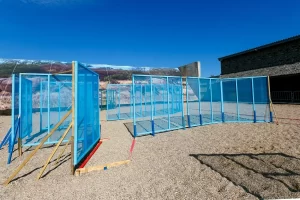
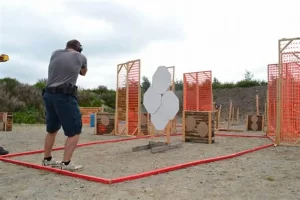
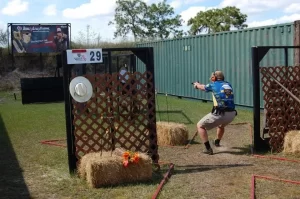
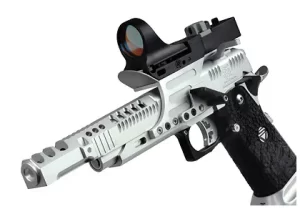
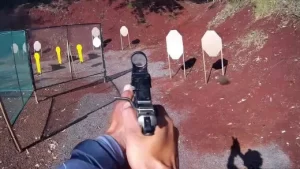
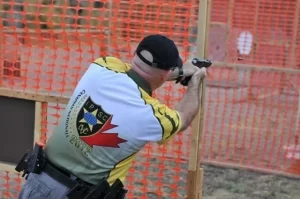
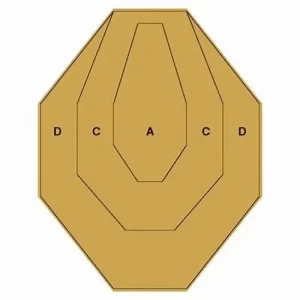

International Shooting Sport Federation (ISSF)
As the premier target pistol shooting association in Australia, Pistol Australia maintains the mandate to field Australian target pistol shooting teams to the Commonwealth Games, Olympic Games and other international target pistol shooting competitions.
In all ISSF target pistol shooting events, competitors aim at a 10 ring target in the standing position, use only one hand to fire the pistol and the wrist must be completely free of support. ISSF target pistol shooting events include 10m Air Pistol, 50m Pistol, 25m Pistol, Rapid Fire Stage, 25m Rapid Fire Pistol, 25m Centre Fire Pistol, and 25m Standard Pistol.
10m Air Pistol (Men and Women)
10m Air pistol are ISSF events shot by both men and women, at all levels of
competition up to and including the Olympics and Paralympics.
Target: 10 ring of 11.5 mm diameter, each ring increases by 16 mm
Distance: 10 m
Calibre: .177”, 4.5 mm air pistol - compressed air or gas
Minimum trigger pull: 500 g
Number of shots/time:
60 shots for Men, Women & Junior Men in 90 min (75 min on electronic targets)
The 10m Air Pistol events, and the 50m Pistol event are arguably the most mentally demanding events.
The top 8 women contestants, and the 8 top men contestants having the highest scores progress on to the Men's and the Women's finals, which consists of 20 shots with a shooter eliminated after the eighth shot and after each subsequent 2 shots.
50m Pistol
Formerly known as Free Pistol, the 50m Pistol event is shot at all levels of competition up to and including the Olympics and Paralympics using .22 calibre single-shot pistols.
Target: 10 ring of 50mm diameter, each ring increases by 50mm
Distance: 50 metres
Calibre: .22 long rifle rimfire
There is no minimum trigger pull specified for this event.
Number of shots/time:60 competition shots in six series of 10 shots each with 15 mins for each series (90 min on electronic targets)
In this event the pistol may only be loaded with one round of ammunition at a time and must be operated with only one hand, which cannot be supported in any way. There are practically no rules for the pistol itself, trigger force may be as low as the competitor chooses, the grip may be designed in any way provided it does not give support beyond the wrist, and there are no restrictions on size and weight of the pistol.
The top 8 contestants having the highest scores progress on to the final, which consists of 20 shots with a shooter eliminated after the eighth shot and after each subsequent two shots.
50m Pistol is described as the purest form of precision shooting amongst the pistol events and the match has undergone minimal rule changes over the past 75 years.
In Australia the event is also shot by women at most competitions.
25m Pistol Women and Men's Sport Pistol
Formerly known as Sport Pistol, 25m Pistol women’s event was introduced in the 1960s. Internationally 25m Pistol is only shot up to and including the Olympics by women, and up to and including the Paralympics by men and women, and by juniors at the World Championships, In Australia the event is also shot by men at many State competitions.
25m Pistol combines both precision and rapid-fire, in two stages each of 30 shots
Distance: 25 metres
Calibre: .22 long rifle rimfire
Minimum trigger pull: 1000g.
Precision Stage
Number of shots/time: 30 shots, in six series of 5 shots, each series is 5 minutes
Precision Stage target: 10 ring of 50 mm diameter, each ring increases by 50 mm
After all competitors have completed the Precision Stage, they then fire the Rapid Fire Stage.
Rapid Fire Stage
Number of shots/time: 30 shots, in six series of 5 shots.
Each series consists of 5 exposures of the target, each exposure is for 3 seconds; the shooter fires one shot per exposure.
Rapid Fire Stage target:10 ring of 100 mm diameter, each ring increases by 80 mm.
The top 8 contestants having the highest scores progress on to the final, which consists of two stages. After the first stage of five, additional rapid fire stage series of 5 shots each, four of the top scoring finalists then compete for medal contention.
25m Center Fire Pistol
25m Centre Fire Pistol is one of the ISSF shooting events and at international level is a men-only event.
Other than the calibre used, the Centre Fire event is exactly the same as the 25m Pistol Women, and Men's Sport Pistol events.
The 25m Centre Fire match is shot with a handgun of any calibre between 7.62 mm (.30”) and 9.65 mm (.38”). The most popular choices by far are specially designed sport pistols and revolvers in .32 calibre. Using a revolver is not a disadvantage because there are no speedy series of shots involved. The name Center-Fire comes from the ignition system of these calibers as opposed to the Rimfire of .22 cartridges.
There is no Final round for the Centre Fire Pistol event. In Australia this event is also shot by women at most competitions.
25m Rapid Fire Pistol
In 25m Rapid Fire Pistol competitors use semi-automatic pistols in .22 calibre (5.6mm) at all levels of competition up to and including the Olympics. A series (or string) consists of five (5) shots fired, one at each of five target within a limited time.
Five targets stand next to each other at a 25m distance from the shooter. When the targets appear, the competitor must raise his/her arm from a 45 degree angle and fire his/her five shots. If a shot is too late, it will score as a miss.
Target: 10 ring of 100 mm diameter, each ring increases by 80 mm
Distance: 25 metres
Calibre: .22 long rifle rimfire
Minimum trigger pull: 1000g.
Number of shots/time: 60 competition shots, fired as two stages of 30 shots.
There are three different time limits: 8 seconds, 6 seconds and 4 seconds for the series. A stage consists of two series in each time, and a full course of fire comprises two such stages.
The top 6 contestants having the highest scores progress on to the final, which consists of four additional rapid-fire stage series of 5 shots each, fired in the 4-seconds sequence. The final score is added to the qualification score.
In Australia this event is also shot by women at most competitions.
25m Standard Pistol
25m Standard Pistol is one of the ISSF shooting events introduced at the World Championship level in 1970.
Target: 10 ring of 50 mm diameter, each ring increases by 50 mm
Distance: 25 metres
Calibre: .22 long rifle rimfire
Minimum trigger pull: 1000g.
Number of shots/time: 60 competition shots, fired as four stages of 20 shots.
The 60-shot match is divided into 5-shot series with different timings:
4 series of 5 shots within 150 seconds for each series
4 series of 5 shots within 20 seconds for each series
4 series of 5 shots within 10 seconds for each series
There is no Final round for the Standard Pistol event
In Australia this event is also shot by women at most competitions.
International Shooting Sport Federation (ISSF) Gallery
